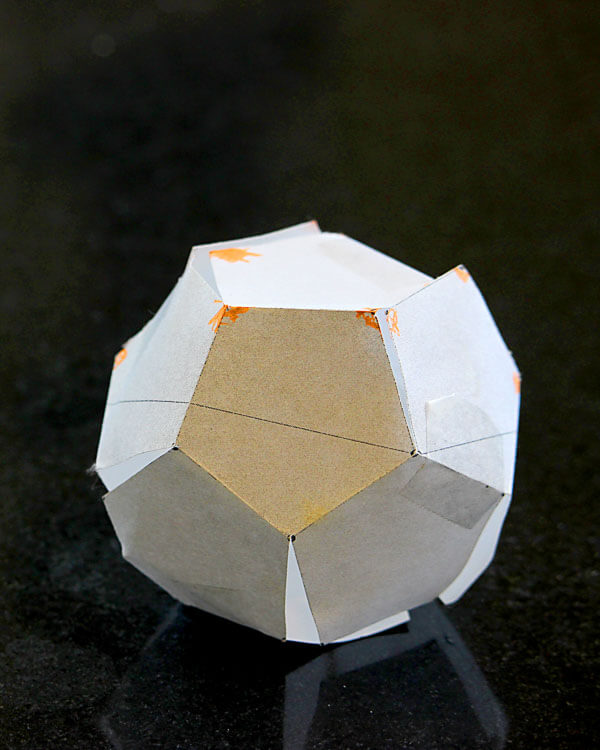For Associate Professor of Mathematics David Aulicino, his eureka moment was nowhere near that of the ancient Greek scholar Archimedes, who supposedly shouted the word after seeing the water in his tub rise when he immersed himself, instantly realizing he had the answer to the long-sought-after solution to measuring volume and density.

A dodecahedron, one of five Platonic solids and the one which created a stir in the world of mathematics.
In 2018, Aulicino asked a colleague at the CUNY Graduate Center in Manhattan to print out a pattern he had created on a freeware geometry program. He cut out the shape, folded it, and taped it together. The result was a dodecahedron, a three-dimensional shape with 12 flat pentagonal surfaces. Theorems on blackboards are a common thing, but Aulicino was holding this one in his hand. The paper shape was the answer to a fundamental question about the structure of Platonic solids, five regular three-dimensional geometrical solids—tetrahedrons (or pyramids), cubes, octahedrons, icosahedrons, and dodecahedrons. Starting at a corner of a Platonic solid, can one trace a straight path that would bring him or her back to the starting point without passing through any other corner? The paper shape proved that not only one but an infinite number of these paths exist on the dodecahedron. The discovery made a stir in the math world.
The story of Platonic solids and straight paths and trajectories and the recent discovery began the year Aulicino joined the faculty at Brooklyn College and includes two peers, Jayadev Athreya, professor of mathematics and comparative history of ideas at the University of Washington, and City College of New York mathematics Professor Patrick Hooper. The three have been friends and colleagues for a decade, having met at conferences in the earlier days of their careers.
“Jayadev and I were sitting in his office and started playing around with some precut cards that you can fold up into Platonic solids,” says Aulicino. That got the two mathematicians thinking about work being done on trajectories. It was the next year, when the two spoke with Samuel Lelièvre, a colleague from the Université Paris-Saclay, that things began to come together. “He told us about the problems with the first four Platonic solids, that you could not draw a continuous path without hitting one of the other corners,” says Aulicino. The theory was that the fifth, the dodecahedron, would yield the same result. It did not. The dodecahedron was the exception.
From there, he and Athreya wrote the code that Aulicino fed into a freeware geometry program. It produced the printout that led to his eureka moment. The findings were published in American Mathematical Monthly (pdf). Hooper joined them and they found that there were infinitely many trajectories that could be classified into 31 different types.
In the rarified world of advanced mathematics, the trio’s discovery is a very big deal. Said University of Chicago Professor Howard Masur in Quanta Magazine, the “analysis is an elegant solution. It’s one of these things where I can say, without any hesitation ‘Goodness, oh, I wish I had done that!’” But what Aulicino perhaps likes most about it is how it might inspire future mathematicians. “I work with high school students at our STAR [Science, Technology, and Research] Early College program. I can say, ‘Look, here is a new theorem from 2019’ and show them that all discoveries do not live in the past.”
Return to the BC Magazine



